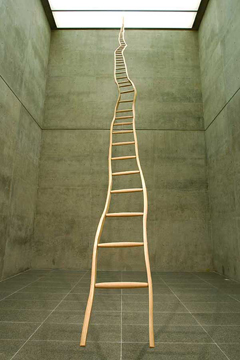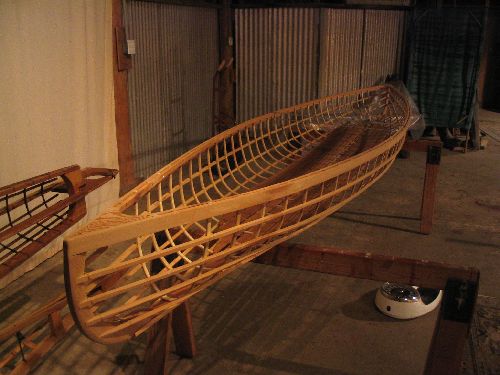Thursday, October 27, 2011
bow-making and the anatomy of wood
Anyhoosenheimer, I thought I would just share a bit of the info on the anatomy of wood that the author's describe in this book. I learned that there is so much more to the intricacies of a tree than I had ever imagined, and it is these intricacies that make or "break" a bow.
All trees can be used for successful bows, but it is important to know where in the tree to retrieve the wood. Interesting, it is, and overwhelming at the same time.
Here you go with a much condensed version of what I read.
First of all there are many factors about wood that are used to decide which part will work for a bow. Looking at the anatomy of the wood, the annual rings, the grain, the age and density,the reaction, tension and compression wood, branch wood, decay, etc. one can pick out a wood suitable for a nice strong bow.
Wood is formed only by a thin layer of living cells between bark and wood, called the cambium. The cell wall is long-chain molecules of cellulose that provides tension strength, lignin compression strength. As the tree grows, the inner portions of the trunk are no longer needed to bring water and nutrients to the leaves and this inner portion is transformed into heartwood. Sapwood becomes heartwood as the tree creates and deposits chemical and mineral extractives in the cells. This is interesting: sapwood is not resistant to fungi, but heartwood is toxic to fungi.
Sapwood can be compression-weak compared to the heartwood, yet one year later when extractives have been infused into the inner sapwood ring, that sapwood, now heartwood is a different creature. Every heartwood serves well in both tension and compression meaning it is good for bows.
Heartwood as well as sapwood is dead wood, and unless discolored by decay or compromised by insects, weathering or physical trauma it's as sound as if new. So in theory any old wood can be fine for bow-making, whether from the inside of a tree, basement storage pile or old doors or flooring. Good to know.
And here's something interesting that I didn't know - Hardwood is called porous wood. Who would've thunk. It's called this because conduction and support are performed by large-diameter, thin-walled cells called pores. Softwood is called non-porous wood. When the pores are concentrated in the early wood like oak, pecan, elm, Osage and ash they are said to be ring-porous woods. If they have evenly distributed pores like cherry, maple, and birch they are called diffuse-porous woods. Semi ring-porous woods like black walnut and persimmon have pores that are larger in the early wood, and become smaller toward the latewood with no distance transition. I know, I know-TOO MUCH INFORMATION, but you have to admit it is interesting and you didn't know it already. OH, maybe you all did, and I am just way too slow for you guys.
Here's something about the annual rings. If ring-porous hardwood rings are thin (many rings per inch) it will be light and weak and not usable for normal-weight bows. Unnaturally wide rings may also be less dense and weaker. But unlike hardwoods, the more rings per inch in conifers the denser the wood. It states in the book that if unhappy with a tree's surface ring structure one should explore deeper, where the wood may be thicker-ringed and denser.
Okay now a word about reaction wood- tension wood, compressions wood. For trunks to straighten themselves once moved from vertical, or to prevent branches bending down from their own weight, hardwood trees lay down tension-strong, cellulose-rich tension wood on the top side of trunks and branches. Conifers lay down denser and thick-ringed, higher lignin content compression wood on the bottom side. Wood with high lignin content is especially strong in compression. Most conifer species produce inadequate bow wood, but the bottom, compression side of horizontal branches can be sinew-backed, yielding first-class results. Compression wood shrinks or expands with moisture content (MC) changes 10 times or more than normal wood. Tension wood contains more cellulose than normal wood, so is especially strong in tension. The tension-wood side of a split stave will often dry into reflex. Hardwood reaction wood rings are not always eccentric as in conifers, so it's important to make the upper side before felling. If the top of such staves are not centered at bow back much twisting and warping will occur.
Anyhoosenheimer, that's a bit about the anatomy of trees from "bow-making eyes", but honestly, I am still confused. If anyone knows of an expert on bow-making let me know. I'd love to actually see all these things that are written, so it makes more sense. From the sounds of it I should be able to make a bow from the old back-porch door I've been storing for a million years. If that works I'll move onto some fabulous arrows with obsidian tips.
Nathan Cox - Northwest Coast Wood-Carving
My earliest exposure to art of the Northwest Coast peoples, or at least the earliest that I remember, came from the Field Museum in Chicago. The collection was tucked away on the main floor, somewhere behind a room full of faceless mannequins dressed in traditional attire from the Great Plains nations. At the back of this room, taking up the entire wall, was a life-size replica of a Pawnee earth lodge. As I remember it, the door into the Northwest Coast/Arctic room was sort of hidden around the back of this lodge (that could have been a decision meant to ease the transition between the two distinct geographical regions, but just as likely the curatorial team had an awkward time finding a good space for that big ass lodge and that was their weird solution*). Whatever the reason, stepping through that doorway always felt like one of those down the rabbit hole experiences to me. And cut to . . .
The gallery was a completely different kind of space. I was large, dark and silent. It still seems a little spooky, even now. I did spend the night in there once, though. It was worth it for that collection. There was the standard artifacts (dogsleds, whaling/hunting paraphernalia, giant crabs, etc.), but what always stuck in my memory was the collection of wood carvings. There is a very distinctive aesthetic associated with Northwest Coast art that makes it instantly recognizable. Wood is the traditional material for most carvings, though the Haida have a long tradition of working in Argillite and many contemporary artists have recently taken up bronze. Whatever the medium, methods are almost universally traditional: artists work their materials using hand tools (axes, chisels, adzes, etc.) and large pieces are erected manually by members of the community. Though the concept and design details often vary based on the needs of the community, themes drawn from mythological, religious, cultural and historical (both societal and familial) sources are especially popular. Figures walk a blurred line between representation and abstraction, with forms that are identifiable as both organic and geometric (or, just as easily, as neither). Deeply-carved lines are complemented by a sparse palette (rarely more than 3-4 colors, if any), enhancing the effects of light and shadow on the piece's surface. Though worked almost entirely by hand, experienced carvers are able to produce a remarkable level of consistency in their treatment of the material, producing near-perfect symmetry and balance. As most objects are worked down from a single mass, joinery is typically minimal (aside from the occasional outstretched wing of a bird, or basic bindings for an articulated mask) and each piece retains strong references to its natural structure.
This faithfulness is not limited to aesthetics, but finds expression in the social life of a piece. As mentioned above, the construction and erection of a totem pole is rarely an isolated act. While the actual production is typically carried out by a single artist or a small group, the commission comes on behalf of the entire community, which takes part in the installation and dedication. Furthermore, once erected, poles are rarely maintained. Instead, in reference to their origins, they are left to the elements until they fall of their own accord (or, in some cases, they are deemed hazardous and removed). This lends to the carvings a sense of placement and fragility not immediately evident from the appearance alone, which allows them to become something more than a narrative or a commemoration. That seems to be the attraction for me. I come for the craft, but I stay for the perspective.
*Now that I think on it, the lodge shared a wall with the Northwest Coast gallery. There was a diorama of a wolf den and some Inuit dwellings on the opposite side. It all makes sense now.




Sources:
http://www.nfb.ca/film/bill_reid (A short documentary from the Canadian National Film Board, featuring Bill Reid's construction of a totem pole for the town of Skidegate, BC)
http://www.biographi.ca/009004-119.01-e.php?&id_nbr=7354 (A short biography of Charles Edenshaw, a key figure in the 19th century revival of Haida art)
http://www.royalbcmuseum.bc.ca/MainSite/ (The Royal British Columbia Museum - they have a large collection of Northwest Coast art, although their online catalog is under construction)
http://www.nfb.ca/film/totem_the_return_of_the_gpsgolox_pole/ (Another Canadian National Film Board documentary, dealing with issues of ownership in indigenous art)
http://www.spiritwrestler.com (A Vancouver gallery specializing in contemporary Inuit, Northwest Coast and Maori art)
Wednesday, October 26, 2011
Japanese Woodwork
Tuesday, October 25, 2011
Jonathan Huang


Nick Schade The Hatori Hanzo of Kyak makers!




I stumbled upon Nick Schades work while researching what other artists and craftsmen are were making out Cedar (Cedar is the primary material of Ursula Von Rydingsvard). Nick Schade a former Navy engineer, made his first Kayak in 1986 out of the belief that he could make a sea worthy, responsive, light and durable kayak from the strip built method.
Sunday, October 2, 2011
Martin Puryear
Martin Puryear is an American sculptor working primarily in wood. While many other artists of his generation explored the aesthetics of industrial processes and materials, Puryear looked back to old techniques and placed and emphasis on craft and the handmade. Although his pieces used the same formal vocabulary of minimalism and post-minimalism, communicating ideas through material and basic elements of form such as interior and exterior, he also placed an emphasis on the metaphorical potential of technique. As curator Elizabeth Reede, “His basic vocabulary is made up of forms derived from everyday objects, both natural and manmade, from Africa, Scandinavia, Lapland, Japan, and elsewhere, including tools, vessels, and furniture as well as from domestic and public architecture and landscape” (Reede). In this way, in addition to the materials and forms he employs, the many construction techniques he borrows from various crafts allow him to convey meaning and reference cultures and their histories.

Saturday, October 1, 2011
Theresa N: Ursula von Rydingsvard
 |
| Detail of Ocean Floor |
The interest in this artist's body of work is that one can meditate on it as a collection of deliberate statements about the relation of “woodliness” to time, to the elements, and to human beings. Such properties of being “woodly” include but are not limited to the grain, texture, coloring, age, mass, its codependence in the planet’s ecological system as well as its principal existence in human cultural systems. As the same properties exploited, or exemplified, in the work, they further enrich any discussion about human relationships with the environment around us, as well as what we may see in future conversations about the conversation of natural resources.
 |
| Mold for Damski Czepek |
 |
| Ignatz Comes Home |







